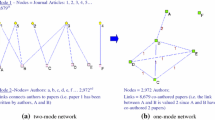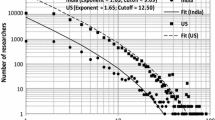Abstract
About ten years ago a new research field called “webometrics” emerged. Similarities between methods used in webometrics and scientometrics or informetrics are evident from the literature. Are there also similarities between scientometric and Web indicators of collaboration for possible use in technology policy making? Usually, the bibliometric method used to study collaboration is the investigation of co-authorships.
In this paper, Web hyperlinks and Web visibility indicators are examined to establish their usefulness as indicators of collaboration and to explore whether similarities exist between Web-based structures and bibliographic structures.
Three empirical studies of collaboration between institutions and individual scientists show that hyperlink structures at the Web don’t reflect collaboration structures collected by bibliographic data. However Web visibility indicators of collaboration are different from hyperlinks and can be successfully used as Web indicators of collaboration.
Similar content being viewed by others
References
Aguillo, I. (2004), Comments about personal Web-pages in academia and research (Discussion paper, unpublished).
Beaver, D. Deb. (2001), Reflections on scientific collaborations (and its study): Past, present and prospective. Scientometrics, 52: 365–377.
Brin, S., L. Page (1998), The anatomy of a large scale hypertextual web search engine, Proc. WWW, 1998.
Cothey, V., H. Kretschmer (2004), Does the link structure of the web provide evidence of a collaborative hypertext? Journal of Information Management and Scientometrics, Vol. 1, No. 2 (to appear).
Glänzel, W. (2002). Coauthorship patterns and trends in the sciences (1980–1998): A bibliometric study with implications for database indexing and search strategies. Library Trends, 50: 461–473.
Glänzel, W., A. Schubert (2004), Analyzing scientific networks through co-authorship. In: H. F. Moed et al. (Eds), Handbook of Quantitative Science and Technology Research, The Netherlands: Kluwer Academic Publishers, pp. 257–276.
Glänzel, W., C. De Lange (1997), Modeling and measuring multilateral co-authorship in international scientific collaboration. Part II. A comparative study on the extent and change of international scientific collaboration links. Scientometrics, 40: 605–626.
Gupta, B. M., H. Kretschmer, I. Aguillo (unpublished), Indo-German collaboration in S& T: an analysis through co-authored publications, 1993–2001, and Web visibility.
Heimeriks, G., M. Hoerlesberger, P. Van Den Besselaar (2003), Mapping communication and collaboration in heterogeneous research networks. Scientometrics, 58: 391–413.
Kling, R., G. McKim (2000), Not just a matter of time: field differences and the shaping of electronic media in supporting scientific communication. Journal of the American Society for Information Science, 51(14): 1306–1320.
Kretschmer, H., I. Aguillo (2004), Visibility of collaboration on the Web. Scientometrics, 61: 405–426.
Luukkonen, T., O. Persson, G. Silvertse (1992), Understanding patterns of international scientific collaboration. Science, Technology Q Human Values, 17: 101–126.
Newman, M. E. J. (2001), The structure of scientific collaboration networks. Proc. Natl. Acad. Sci. USA, 98: 404–409.
Okubo, Y., J. F. Miquel, L. Frigoletto, J. C. Doré (1992), Structure of international collaboration in science; typology of countries through multivariate techniques using a link indicator. Scientometrics, 25: 321–351.
Price, D. De Solla (1963), Little Science, Big Science. New York: Columbia Univ. Press.
Tijssen, R. J. W., H. F. Moed (1989), Science and Technology Indicators, Leiden: DSWO Press.
Terveen, L. G., W. C. Hill (1998), Evaluating emergent collaboration on the Web, in Proceedings of CSCW 1998 (Seattle WA, November 1998), ACM Press, pp. 355–362.
Vaughan, L., D. Shaw (2003), Bibliographic and Web citations: What is the difference? Journal of the American Society for Information Science and Technology, 54(14): 1313–1322.
Wasserman, S., K. Faust (1994), Social Network Analysis. Methods and Applications. Cambridge: Cambridge University Press.
Wilkinson, D., G. Harris, M. Thelwall, E. Price (2003), Motivations for academic Web site interlinking: Evidence for the Web as a novel source of information on informal scholarly communication. Journal of Information Science, 29(1): 59–66.
Zitt, M., E. Bassecoulard, Y. Okubo (2000), Shadows of the past in international cooperation: Collaboration profiles of the top five producers of science. Scientometrics, 47: 627–657.
Author information
Authors and Affiliations
Corresponding author
Rights and permissions
About this article
Cite this article
Kretschmer, H., Kretschmer, U. & Kretschmer, T. Reflection of co-authorship networks in the Web: Web hyperlinks versus Web visibility rates. Scientometrics 70, 519–540 (2007). https://doi.org/10.1007/s11192-007-0214-5
Received:
Issue Date:
DOI: https://doi.org/10.1007/s11192-007-0214-5




